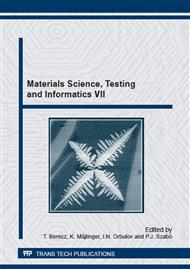p.167
p.173
p.181
p.189
p.195
p.201
p.207
p.213
p.219
Recrystallization of Boron Containing and Boron-Free Low Carbon Steels Investigated by Thermoelectric Power and Hardness Measurements
Abstract:
The measurement of thermoelectric power is a powerful method to investigate the metallurgical processes occurring in steels. In this study, four low carbon cold rolled steel sheets having different composition were investigated. The cold rolled sheets were heated up at heating rate 20 °C/hour up to different temperatures, whilst the change of thermoelectric power and hardness have been measured at room temperature after slow cooling. The thermoelectric power of steels increases with temperature until the recrystallization finishes. The raise of thermoelectric power during recrystallization is ranging between 50 and 160 nV/K, depends on the composition of the sheet. Specimens consist of boron exhibit lower thermoelectric power after recrystallization than the steel without any boron, probably due to metastable borocarbide dissolution. This fact could be a good starting point to investigate the effect of boron on thermoelectric power of steels.
Info:
Periodical:
Pages:
195-199
Citation:
Online since:
February 2015
Authors:
Keywords:
Price:
Сopyright:
© 2015 Trans Tech Publications Ltd. All Rights Reserved
Share:
Citation:


